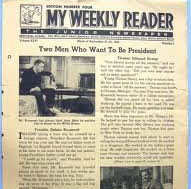When just about anything we want to know is merely a click away, it’s awfully easy to become disenthralled by current events. Everything over five minutes ago is old news. It’s already been tweeted around the world. Probably twice. That said, I got a jolt of nostalgia when I heard that Scholastic is shutting down Weekly Reader.
This kids’ publication has been a fixture in pre-K through high school classrooms since 1902. At one time it had a readership of over 13 million. In 1990, it had one million. At last count, it had less than 350,000.
I’m willing to bet that most of you who are younger than 110 read Weekly Reader at some time during your youth. For me, it was how I learned to read a newspaper. It was my first non-fiction experience, my first exposure to current event discussions, and in all probability, my first tabloid. I can still remember waiting for my teachers to pass out the flimsy papers once a week, and flipping ahead to see what was inside before the rest of the class got to it (I was a Type A by first grade).
I’m not so old-school as to think that all good things shouldn’t end. Weekly Reader had a good run. Kids today want to use the internet, watch TV, and interact with magical images on enhanced screens. As well they should. These are 21st century tools. But what Weekly Reader offered, that none of the instant-gratification media fulfills, was the thrill of the process. The concerted effort it took to actually read an article, look at pictures, think about the story, and then talk about it with your peers. The skills of critical thinking, communicating, and collaborating. The anti tweet /re-tweet/repeat. These skills will never be outdated.
Good teachers, involved parents, and sophisticated curricula can certainly counteract the passivity of progressive media. But that’s easier to imagine than implement. Our jobs are to create 21st century tools (including toys and media) that actively encourage engagement. We need to stimulate kids to ask “why?” even as they’re grabbing our iPhones and downloading games. As media developers and child educators, that “why” needs to be our moral compass.
Good programs exist. News Corporation recently announced a new brand (their word) to re-imagine K-12 education by creating digital products and services for students, teachers and parents. “Amplify will enhance the potential of students with new curricular experiences, support teachers with new instructional tools and engage parents through extended learning opportunities.” It’s an ambitious initiative. New York’s Quest to Learn school is another bold example. They both strive to engage kids in ways that are meaningful today. They go beyond encouraging kids to ask “why” by answering “how.” These models give me hope for the future of education.
But I still wonder if kids are going to learn to read a newspaper.
Let me know what you’re thinking: wendy@sandboxsummit.org






















